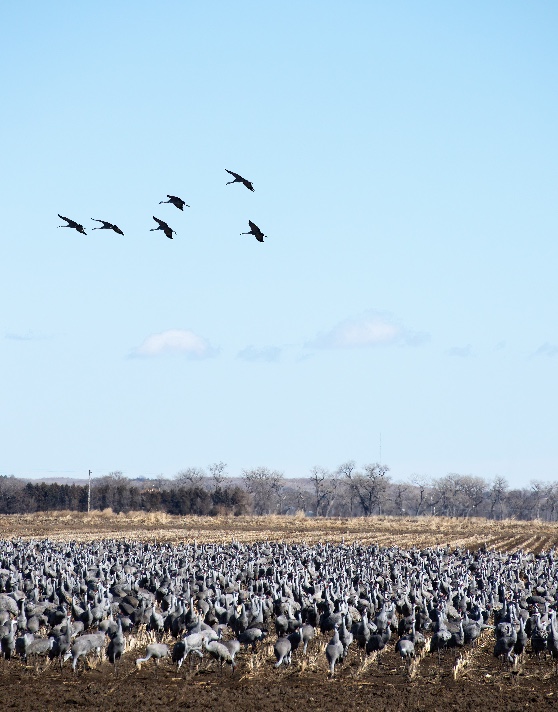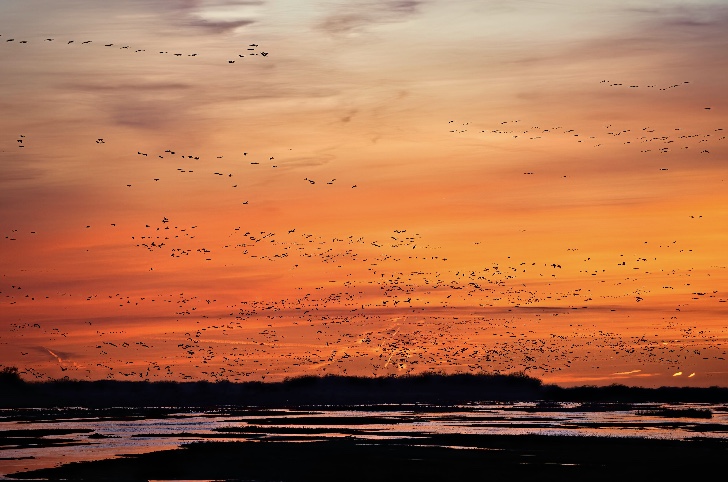Each spring, hundreds of thousands of sandhill cranes gather in Nebraska
By Rebecca L. Rhoades
It’s 6:30 a.m. on a mid-March morning. The skies are still black as we make our way towards two shipping containers repurposed as observation blinds on the edge of the Platte River. It’s brutally cold — in the single digits — and Nebraska’s biting winds howl through small viewing holes cut into plexiglass windows that overlook the shore.
As the dawn’s first rays peek their way above the horizon, faint outlines of several thousand sandhill cranes, still asleep in the gently flowing river with their heads tucked under their wings, begin to emerge.
A hush falls over the blind. Photographers with lenses as long as a human arm stake out their spots. Binoculars are unpacked. Cell phone screens are darkened.
The cranes slowly begin to stir and purr, calling to family members. In concert with the rising sun, the fricative coos and trills are replaced by long, rolling “kar-r-r-oos” that carry across the water. One by one, the cranes begin to stir. In what can only be described as a kind of sandhill morning stretch, necks elongate, dagger-like beaks point toward the sky, and wings unfurl, their black-tipped feathers creating a rippling effect across the flock. Energetic young males dance in a series of gangly yet graceful leaps, bows, and pirouettes.
The sound reaches a crescendo, and just as the sun breaks through the clouds, the statuesque birds take flight. Waves of thousands of cranes lift off en masse from the river and head into the surrounding fields and farmlands.
At night, the scene is repeated in reverse, as the cranes return to their wetland refuges at sunset to roost.
[SUBHEAD] A Millenia-Old Phenomenon
 Every year, from mid-February to mid-April, between 600,000 and 1 million lesser sandhill cranes — about 85 percent of the world’s population — converge on an 80-mile stretch of the Platte River Valley in central Nebraska.
Every year, from mid-February to mid-April, between 600,000 and 1 million lesser sandhill cranes — about 85 percent of the world’s population — converge on an 80-mile stretch of the Platte River Valley in central Nebraska.
Sandhill cranes are one of the most common species of cranes. Standing between four and five feet tall, with a wingspan reaching up to six feet, the silver-gray birds are easily identified by their crimson-red crowns. Their trumpeting call is the product of long curved trachea that helps produce a low pitch that can be heard up to 2.5 miles away. They’re also one of the earliest species of birds: a fossil found in Florida dates back 2.5 million years.
As they have for millennia, sandhill cranes make an annual journey along the Central Flyway from their winter habitats in southern Texas, New Mexico, Arizona, and Chihuahua, Mexico, to nesting grounds in Alaska, the Yukon, and eastern Siberia. They arrive in Nebraska emaciated and spend about 29 days resting, refueling, and fattening up.
During the day, the birds feast on waste grain from last season’s harvest, along with worms, snails, mice, and insect larvae. At night, they return to the safety of the river. According to the Nebraska Game and Parks Commission, the cranes consume nearly 1,500 tons of corn during their stay, and they gain as much as 20 percent of their total body weight.
This annual passage is one of the world’s greatest wildlife spectacles, often compared with the epic migrations of wildebeests and caribou.
“This is one of the last great migrations and the largest one in North America,” says Brice Krohn, president and CEO of the Crane Trust, a nonprofit organization dedicated to protecting and preserving critical habitat for migratory birds. “And this is the only place in the world where you can see it.”
[SUBHEAD] To Protect and Preserve

Founded in 1978 with federal money, the Crane Trust’s original mission was to help conserve the endangered whooping crane. At the time, fewer than 60 of the rare birds existed. Today, the population has increased to almost 700.
Whooping cranes, which are larger than sandhills and almost completely white, also migrate through central Nebraska. They usually follow the sandhills at the end of April. During our visit to the Crane Trust, a lone “whooper” – as they’re affectionately called – had joined the flock.
The Trust is set on about 10,000 acres of critical habitat for whooping cranes, sandhill cranes, and countless other birds and mammals that share the riverine ecosystem. More than 300 species of birds have been documented on the property, including ducks, geese, and grassland nesting birds.
“Climate change is having a major effect on many of these birds through their migratory routes,” Krohn notes. “Everything really is keyed upon their habitat.”
Krohn explains that although the cranes have been migrating through Nebraska for millions of years, the landscape has changed dramatically. Damming of Platte River has decreased the amount of water — throughout the years, it has lost 80 percent of its width and 70 percent of its flow. “We’re on a river that is functioning today, but it’s an over-appropriated or fully appropriated river system,” Krohn says.
Trees and invasive plant species also have encroached on the riverbanks. “Cranes don’t like trees coming up to the edge of the river,” Krohn continues. “They like wide-open views and wet meadows. So, we’re doing a lot of work to keep the prairie throughout the river system. We’re trying to protect the land as you see it today into perpetuity.”
One of the ways the Trust raises awareness and funds is by offering sunrise and sunset viewing experiences. Along with the cranes, about 30,000 out-of-state people visit the Cornhusker State during the six- to eight-week period. Some are serious birders, and the migration is a bucket-list experience. Some are nature photographers. Others come simply to witness one of nature’s wonders. The locals have a name for these avian admirers: Craniacs.
[SUBHEAD] A Must-Do Ecotourism Experience
 During the day, flocks of sandhill cranes take over farmlands and fields across the river valley, from as far east as Chapman and to Overton in the west. Massive seas of gray birds can be seen in cornfields along Interstate 80, which runs parallel to the Platte River. And the Central Platte Natural Resources District maintains several crane viewing decks along the river, complete with free parking.
During the day, flocks of sandhill cranes take over farmlands and fields across the river valley, from as far east as Chapman and to Overton in the west. Massive seas of gray birds can be seen in cornfields along Interstate 80, which runs parallel to the Platte River. And the Central Platte Natural Resources District maintains several crane viewing decks along the river, complete with free parking.
“The cranes will actually be out there among the cattle,” says Dusty Barner, owner of Dusty Trails, an outdoor adventure provider in North Platte. “Watching them come in to land is wild. They drop their legs and just let them hang down from way up above like they’re reaching for the ground already.” Barner offers daytime tours in a converted school bus that takes visitors on a 90-minute trip between North Platte and Hershey, stopping wherever large groups of cranes are found for viewing and photography opportunities.
Brad Mellema is the executive director of the visitor’s bureau for the town of Grand Island. He also is the former executive director of the Crane Trust Nature & Visitor Center, an information and education center, art gallery, and gift shop located just minutes from the Trust’s Wild Rose Ranch. “Midday is nice, seeing the cranes in the cornfield, but I wish more visitors knew that the special thing is on the river,” he says. “This is really where it’s at.” On any given night during the migration season, upwards of 150,000 cranes will roost in the river in front of the observation blinds at the Crane Trust.
Another prime viewing destination and information source is Rowe Sanctuary, a National Audubon Society center in Gibbon. Located on the south shore of the Platte River, the sanctuary offers an unparalleled location for evening viewing.
From a strategically placed west-facing discovery station situated on the banks of the river, we watch in silence as the evening sky glowed in fiery shades of gold and orange. Soon, a distinctive rattle call — kar-r-r-oo, kar-r-r-oo — echoes from above the distant trees. At first, a few V-shaped formations appear. Within minutes, they’re joined by tens of thousands of birds that swoop and swirl, darkening the sky in shape-shifting murmurations and creating an unparalleled cacophony of sight and sound.
As the last flickers of sunlight fade, we make our way back to the center in silent awe. “I always say it vibrates your soul,” Krohn says. “It really does create a spark that makes you at peace with nature.”
For more information about the sandhill crane migration, visit cranetrust.org and rowe.audubon.org. For information about visiting Nebraska, go to visitnebraska.com/sandhill-crane-migration.





